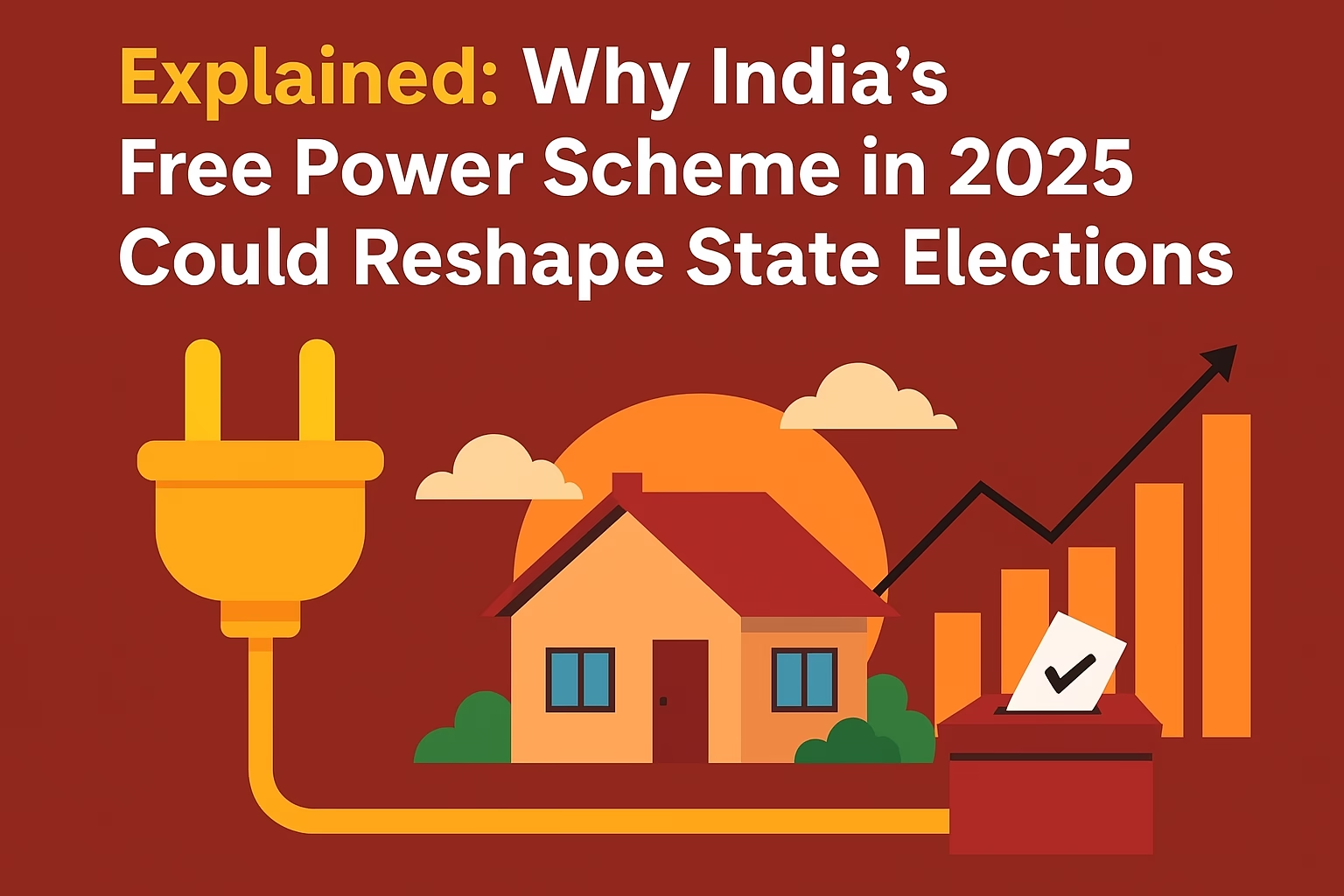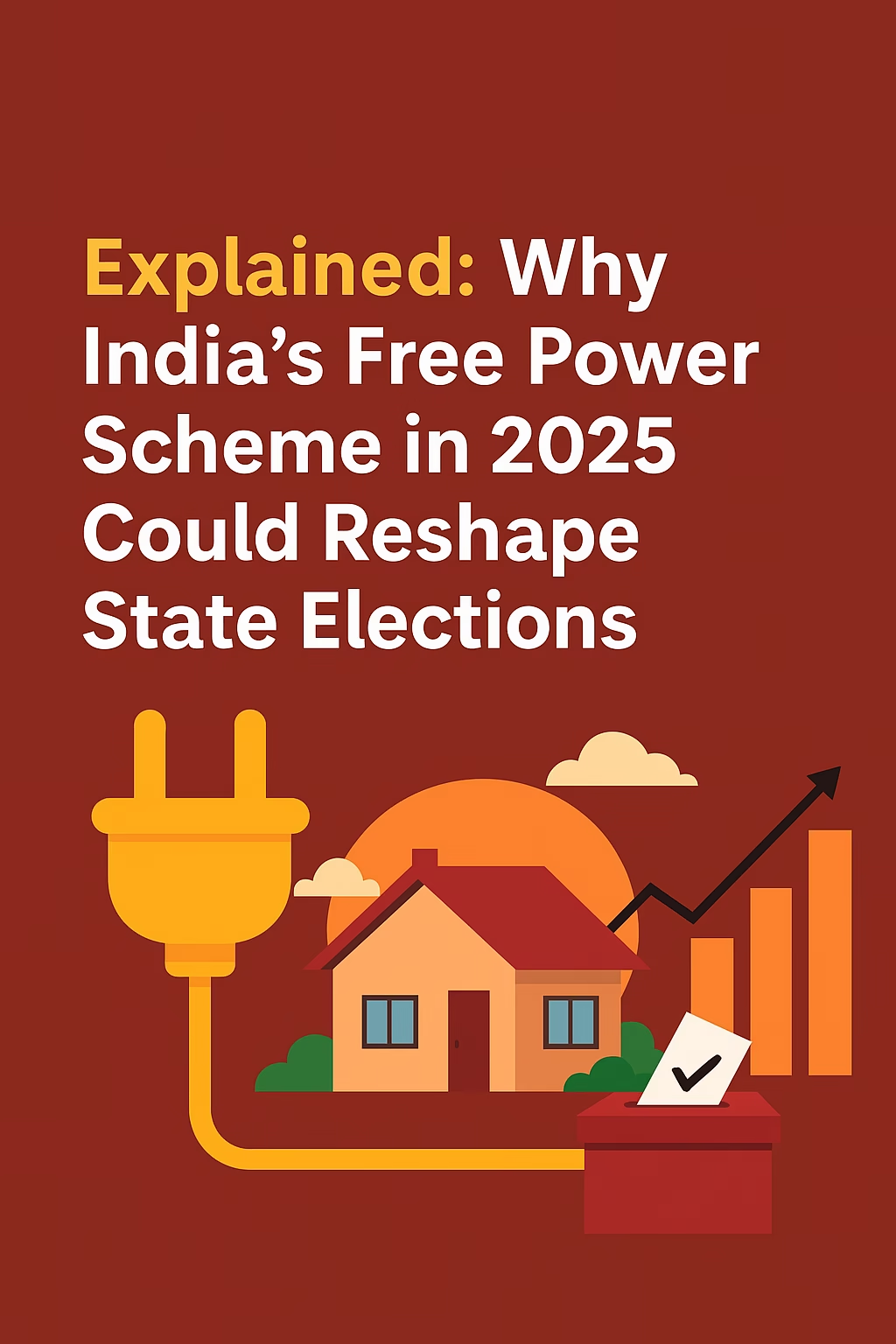🔹 Introduction – When Electricity Becomes Political Power
Electricity has never just been about lights and fans in India—it has always carried political voltage. From rural irrigation pumps to urban apartments, power supply decides not only comfort but survival. In 2025, a new debate is sweeping across Indian politics: “Should electricity be free?”

With several state governments already offering India’s Free Power Scheme 2025, this promise has moved from being a campaign gimmick to a mainstream governance tool. But here’s the real twist: beyond free bills, this scheme could reshape state elections, influence voter behavior, and redefine political strategies in India.
🔹 What is India’s Free Power Scheme 2025?
The Free Power Scheme 2025 refers to state-led initiatives where households are provided a fixed number of free electricity units every month. While the exact details vary across states, the common structure includes:
- Free power up to 100–300 units per household per month.
- Eligibility limits (only residential use, not commercial).
- Direct subsidy to power distribution companies (discoms) to cover costs.
For example:
- Delhi offers 200 units free per household.
- Punjab provides 300 units free.
- Karnataka & Rajasthan rolled out similar policies in 2024–25.
Now, more states are exploring similar schemes before elections.
🔹 How Voters Benefit Directly
Why is India’s Free Power Scheme 2025 such a powerful electoral card? Because it offers tangible, monthly savings for ordinary families.
- A middle-class household using 200–250 units saves ₹1,200–₹1,800 per month.
- A rural farmer with irrigation pumps can save even more.
- For urban tenants, the difference between paying and not paying electricity bills often decides budget flexibility.
Imagine a family saving nearly ₹15,000–₹20,000 annually. In a country where disposable income is low, such savings are politically priceless.
🔹 Political Strategy Behind Free Power
Electricity subsidies are not new in India. What’s new is the scale and timing.
- In the 1990s, free electricity for farmers in Andhra Pradesh changed electoral politics.
- Delhi’s Aam Aadmi Party (AAP) used free power and water as a core governance promise, winning multiple terms.
- Punjab (2022 elections) proved that free electricity is not just urban—it works with rural voters too.
Now in 2025, almost every major state party is adopting this model. Why? Because it appeals directly to the largest voting class—the middle and lower-income groups.
This could trigger a “free power race” where competing parties try to outdo each other with higher units, extended coverage, or even free solar panel installations.
🔹 Economic & Financial Impact
Here comes the complicated part: Who pays the bill?
- State governments bear the subsidy cost by compensating discoms.
- In Punjab, the annual burden is ₹13,000–₹15,000 crore.
- Delhi spends nearly ₹3,000 crore annually on power subsidies.
Economists warn that if more states adopt India’s Free Power Scheme 2025, it could:
- Increase state fiscal deficits.
- Reduce funds for infrastructure and health projects.
- Lead to higher debt, impacting long-term economic stability.
But politically, governments argue that direct benefits to voters justify the cost, calling it an investment in social welfare.
RELATED: India’s New Digital Trade Policy in 2025: What It Means for Small Exporters
🔹 The Silent Voter Psychology
Why does this scheme have such a strong pull?
Because voters trust visible, recurring benefits more than long-term promises.
- A free electricity bill every month acts like a constant reminder of the ruling party.
- Unlike roads or bridges that take years, free power is instant gratification.
- Women, small farmers, and the urban poor—groups with increasing political influence—feel immediate relief.
Case studies show:
- Delhi voters consistently rewarded AAP for free power schemes.
- Punjab’s rural households shifted loyalty in 2022 largely due to electricity promises.
In 2025, this psychology could decide tight contests in states like Haryana, Bihar, and Maharashtra.

🔹 Criticism & Challenges
Not everyone is cheering. India’s Free Power Scheme 2025 faces several criticisms:
- Unsustainable Cost: Subsidies could cripple state finances.
- Power Theft: Free supply often leads to illegal connections.
- Burden on Discoms: Already debt-ridden power companies may collapse without proper compensation.
- Inequality: Wealthy households using less electricity benefit equally as poor families.
Experts argue that instead of blanket free power, targeted subsidies or direct benefit transfers (DBT) would be more sustainable.
🔹 How It Could Reshape State Elections in 2025
Here’s where it gets politically electrifying.
- In states heading to polls in 2025, free electricity is becoming a central poll issue.
- Parties are framing their campaigns around monthly savings for households.
- Farmers, small shopkeepers, and women voters are emerging as key beneficiaries.
Political analysts suggest that in closely contested states, this single issue could swing 5–8% of the vote share, enough to decide governments.
In short, India’s Free Power Scheme 2025 is not just about bills—it’s about ballots.
🔹 Future of India’s Energy Politics
Looking ahead, the free power debate will likely expand into:
- Solar Power Subsidies: Instead of giving free units, states may offer free rooftop solar panels.
- Smart Meters & Limits: Free power could be capped more strictly to prevent misuse.
- Green Subsidies: Linking free electricity to renewable sources could balance both votes and environment.
India’s politics may shift from “free electricity” to “free clean electricity” in the coming decade.
FOLLOW TIME OF HINDUSTAN ON FACEBOOK
🔹 Conclusion
India’s Free Power Scheme 2025 is more than a subsidy—it’s a political revolution. By directly cutting household expenses, it has the potential to reshape voter behavior, redefine state election strategies, and even rewrite India’s welfare politics.
But the real question remains: Will free electricity empower people in the long run, or will it shock state economies into deeper crises?
Either way, one thing is clear: in 2025, the fight for votes is no longer just on political stages—it’s now playing out every month on your electricity bill.
